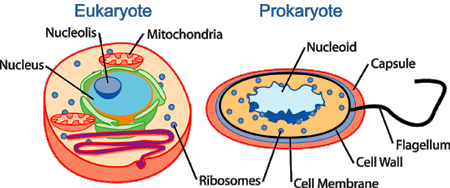Nucleoid
 From Wikidoc - Reading time: 2 min
From Wikidoc - Reading time: 2 min
|
WikiDoc Resources for Nucleoid |
|
Articles |
|---|
|
Most recent articles on Nucleoid |
|
Media |
|
Evidence Based Medicine |
|
Clinical Trials |
|
Ongoing Trials on Nucleoid at Clinical Trials.gov Clinical Trials on Nucleoid at Google
|
|
Guidelines / Policies / Govt |
|
US National Guidelines Clearinghouse on Nucleoid
|
|
Books |
|
News |
|
Commentary |
|
Definitions |
|
Patient Resources / Community |
|
Directions to Hospitals Treating Nucleoid Risk calculators and risk factors for Nucleoid
|
|
Healthcare Provider Resources |
|
Causes & Risk Factors for Nucleoid |
|
Continuing Medical Education (CME) |
|
International |
|
|
|
Business |
|
Experimental / Informatics |

In prokaryotes, the nucleoid (meaning nucleus-like and also known as the nuclear region, nuclear body or chromatin body) is an irregularly-shaped region within the cell where the genetic material is localized. The nucleic acid is a circular, double-stranded piece of DNA, and multiple copies may exist. This method of genetic storage can be contrasted against that of the eukaryotes, where DNA is packed into chromatins and sequestered within a membrane-enclosed organelle called the nucleus.
Visualisation[edit | edit source]
The nucleoid can be clearly visualised on an electron micrograph at high magnification, where, although its appearance may differ, it is clearly visible against the cytosol. Sometimes even strands of what is thought to be DNA are visible. By staining with the Feulgen stain, which specifically stains DNA, the nucleoid can also be seen under a light microscope. The DNA-intercalating stains DAPI and ethidium bromide are widely used for fluorescence microscopy of nucleoids.
Composition[edit | edit source]
Experimental evidence suggests that the nucleoid is largely composed of DNA, about 60%, with a small amount of RNA and protein. The latter two constituents are likely to be mainly messenger RNA and the transcription factor proteins found regulating the bacterial genome. Proteins helping to maintain the supercoiled structure of the nucleic acid are known as nucleoid proteins or nucleoid associated proteins and are distinct from histones of eukaryotic nuclei. In contrast to histones, the DNA-binding proteins of the nucleoid do not form nucleosomes.
See also[edit | edit source]
References[edit | edit source]
- Prescott, L. (1993). Microbiology, Wm. C. Brown Publishers, ISBN 0-697-01372-3
de:Kernäquivalent ko:핵양체 it:Nucleoide lt:Nukleoidas sr:Нуклеоид sh:Nukleoid fi:Nukleoidi uk:Нуклеоїд
 KSF
KSF